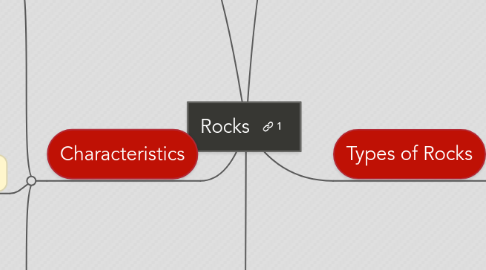
1. Characteristics
1.1. Grain Size
1.1.1. Coarse Grained
1.1.1.1. Mineral grains can be seen with the naked eye.
1.1.2. Fine Grained
1.1.2.1. Mineral grains are too small to be seen with the naked eye.
1.1.3. Slate: Very Fine
1.1.4. Phyllite: Fine
1.1.5. Schist: Medium to coarse
1.1.6. Gneiss: Medium to coarse
1.1.7. Marble: Medium to coarse
1.1.8. Quartzite: Medium to coarse
1.1.9. Anthracite: Fine
1.2. Hardness
1.2.1. Determine what a stone might be used for
1.2.2. Measured by Moh's Scale of Hardness
1.3. Appearance
1.3.1. Igneous
1.3.1.1. Serpentine minerals light to dark green
1.3.1.2. Varied in hue
1.3.1.3. Greasy looking
1.3.1.4. Slippery minerals
1.3.2. Sedimentary
1.3.2.1. Vary in appearance
1.3.2.2. Sandstone have small grains of quartz, feldspar & shiny
1.3.2.3. Limestone made from calcite & is white
1.3.3. Metamorphic
1.3.3.1. Altered mineralogy, texture & chemical composition
1.3.3.2. Sometimes green, gray orange. Usually red
2. Original rock is igneous.
3. Made up of minerals
4. Types of Rocks
4.1. Igneous
4.1.1. Intrusive
4.1.1.1. More time to solidify
4.1.1.2. Coarser Grain, larger crystals
4.1.1.3. E.g. Granite
4.1.2. Extrusive
4.1.2.1. Caused when lava spews out
4.1.2.2. Finer grain, smaller crystals
4.1.2.3. E.g. Basalt
4.1.2.4. Tuf
4.1.2.5. Pumice
4.1.2.6. Obsidian
4.2. Sedimentary
4.2.1. What creates?
4.2.1.1. Weathering & erosion
4.2.1.2. Deposition
4.2.1.3. Compacting & Cementing
4.2.2. E.g. Limestone
4.2.3. Sandstone
4.2.4. Shale
4.2.5. Conglomerate
4.3. Metamorphic
4.3.1. What creates?
4.3.1.1. Heat
4.3.1.2. Pressure
4.3.2. E.g.Gneiss
4.3.3. Marble
